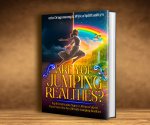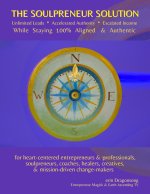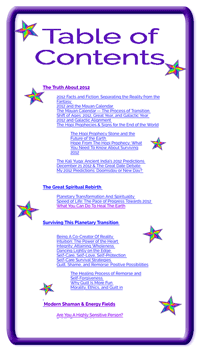Learn How To Visualize

|
|
|
|
|
Learning How To Visualize
Learning how to visualize is a three-fold process . . . 1) Learn to use your senses more consciously. 2) Learn to use your imagination more consciously. 3) Learn to use symbols more consciously. We'll look at each of these in turn. These steps will teach you how to visualize quite easily. And then we'll have some helpful tips for learning how to visualize.Visualizing With Senses
If you want to practice how to visualize, waking up your senses is the first step. What this means is becoming aware of what you see, hear, smell, taste, touch, and feel. If this seems silly to you, you are probably unaware of just how inactive your senses are, on a daily basis. I remember an episode of M*A*S*H, when Hawkeye loses his eyesight in an accident. At first he was devastated. Then he began to notice things with other senses that he'd been oblivious to when he could see. The sound of rain falling on the ground is exactly how bacon sounds when it's frying, for instance. In the end, he regains his sight and his friend congratulates him on his luck. Hawkeye responds that he was lucky twice . . . once to lose his eyesight, and then to gain it back. In other words, he gained the gift of awareness of his other, unacknowledged senses. Noticing what your senses actually observe is the first step in learning how to visualize.Visualization Exercise #1
There's a spiritual practice in Kundalini Yoga in Swami Radha's book Kundalini Yoga for the West that is very useful in learning how to visualize. It's deceptively simple, as so many of her practices are, yet profound in outcome. It consists of blindfolding yourself and, with the help of a friend, using your other senses to really experience material life — a process at the very heart of Wicca! You can have your friend offer you various things to taste, to smell, to hear, to feel. After each one, write a bit about the experience in your journal. This will begin to really awaken your senses to what is around you – you begin by practicing how to "visualize" what you actually perceive! It will also give you useful information on what senses are clear for you, and which are relatively undeveloped. It is in developing all your senses to equal clarity that you begin to gain the power to visualize.Visualization Exercise #2
Another great practice is to take a walk, with the intention of complete awareness of all your senses. Try not to let anything slide by without conscious awareness of it. Notice . . .- every rock and being and cloud and individual blade of grass,
- every sound, whispered or strident,
- every scent, elusive or potent,
- every taste on the breeze or on your tongue,
- the temperature of the various parts of your body,
- the feeling of the ground beneath your feet . . . .
- How are you feeling, emotionally and physically, from moment to moment?
- Where do you feel that in your body?
- What does it feel like?
- How long does it stay, and when does it shift?
- What does it become then?
Visualizing With Imagination
Another part of visualization technique is the ability to use your imagination. So developing your imagination is critical to your visualization success – at least in terms of creating your own reality through visualization. This step is so important, there are a number of exercises on how to visualize with your imagination.Visualization Exercise #3
Here's where you can experience how to visualize for yourself. Remember the exercise where your friend helped you experience your senses? This time, you'll explore how to visualize it in your imagination. Imagine holding a half a lemon in your hand. Hold your hand out in front of you. . . you might feel the weight of it. Can you imagine the texture, all pitted and waxy smooth? Imagine bringing the lemon up to your nose. . . go ahead and lift your arm up. Sniff the air . . . can you pick up a hint of lemony freshness? Now imagine putting the lemon to your lips, and sucking out the juice. Taste that lemon! Do you notice your taste buds squirting? Your body already knows how to visualize . . . it does it all the time. Your body reacts to visualization exactly as if it were the real thing! . . . Which is why it is so crucial to gain command of your mind's imagination. This also proves that, even though you may not be aware of clearly imagining things, the imagination happens. You already know how to visualize! These exercises are therefore designed more to help you realise that you can already vividly imagine things, than to develop an ability you have subconsciously mastered.Visualization Exercise #4
On a blank piece of paper, with a fat black marker, print the first letter of your first name, big and clear. Then hang this on a wall in front of you. Sit right in front of the letter, at just the distance that you can see it best. Look carefully at the letter. . . study it with full attention. Then close your eyes. Imagine you're looking at that piece of paper. Imagine seeing the letter in front of you, at the perfect distance for perfect viewing. Can you see the letter in your mind's eye? It will appear there. But if you're not used to using your imagination, it might flash so quickly at first that you don't notice anything. Don't strain. When you lose the image, or if you can't really see it yet, simply open your eyes and look at the paper again. Study the image. Then close your eyes and imagine you still see it. Keep doing this until your mind understands how to visualize the letter with your eyes closed, as well opened. Of course you won't really see it, not like it is on paper. Not at first, anyway. But over time, it will get clearer and clearer until you realise you can see it perfectly clearly with your eyes closed. This is the fascinating thing about imagination. It's not so much that you can't see it perfectly right from the start. It's that you don't realise you can see it. This may not make much sense to you right now, but you will know what it means, after the fact.Visualization Exercise #5
Close your eyes. Bring to mind someone you love and see very often. Think of their hair. What colour is it? Is it curly or straight or in–between? How long is their hair? Is it hanging near the eyes, or back from the ears, or where? What colour does it shine, when the sunlight hits it? Can you smell their hair, in this imaginary scene? How does it move, when they move their head? Of course you don't see the person's face. You are imagining that you see it. Just concentrate on one physical feature at all time. Now think of their eyes. What colour are the eyes? Are they close, or far apart, or in–between? Are they level with each other? Can you imagine what small flecks of colours are within the eyes? Think of the eyelashes: what are they like? And the eyebrows: are they low or high, straight or arched, thin or thick? What colour are the eyebrows? You can put together the face of a person that you love in this manner. You can imagine their entire body, and then go on to imagine the room they are in. Use as much detail as you can, at whatever stage you care to take this.Visualizing With Symbols
This is a necessary part of the visualization process, because all visualization is through symbols. The letter "C" we used above, for example, means nothing. It is simply a curving line. Any meaning we ascribe to it is symbolic. As a road map is symbolic of the actual terrain. As a photo of a loved one holds the meaning, for us, of the actual person. . . it is symbolic of that person. In fact, anything that has meaning or importance to us is a symbol of something else. Even your loved ones: they are symbols of love, and happiness, and various other ephemeral states. Any visual – or other sensory – image is symbolic. And the deeper you go into spirituality, the more importance symbolism gains. Because anything of value in life is a symbol or represented by a symbol. So without going any deeper into the background, let's practice learning how to work with symbols.Visualization Exercise #6
One of the easiest ways to begin to gain awareness of symbolism in your life is to work with your dreams. This process is explained in the article on dream work.Visualization Exercise #7
The advanced method of dream work is exploring your waking dreams. In other words, what is the symbolism of the events that occur in your life? In this exercise, you write down events that happen in your life, and then interpret them exactly as you would a dream. You can start with the big things or the small things. A butterfly landing in your path may be every bit as significant as a 12–car pileup on the way to work. Perhaps even more so! A random thought while brushing your teeth, an interaction with a colleague, the type of work you do today... all of these can be worked with as waking dreams. One of the best ways to start is to pick a period of time for each day, in which you will be alert for subtle messages. The first hour of work after lunch, or whenever you are walking somewhere, or during phone calls. . . . Any time will do, because once the Universe knows you're listening at a certain time, it'll be sure to call you up! When you practice this for a while, you will develop a refined sensitivity for the subtle messages that the Divine is always trying to send you. And this sensitivity to symbolic messages will improve your visualization technique, especially in the realm of creating your own reality through visualization.With Brightest Blessings,
erin Dragonsong

Return from
Learning How To Visualize
to
Learning How To Visualize










